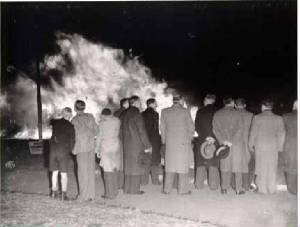|

|
| 1951 - camel rides at Sanctuary |

|
| 2013 - Beckett Park Tower |
|
| 1946 - "Razorback" the donkey! |

|
| 1946 - the author (at rear) on "Razorback" |
NORTH BALWYN WILDLIFE SANCTUARY AND BECKETT PARK BONFIRES
In the 1940s, a large animal sanctuary known as "WIldife Park" started, fronting Greythorn Rd, and bounded
by Alpha St, Frank St and Greythorn Park, North Balwyn.
Over the years it became a popular attraction for family outings, especially
on weekends when an open four-horse drag transported patrons from the Mont Albert
tram terminus until 1947 when it was replaced by a bus.
The drags were run by a Dick Gibbs from
his horse contracting business in Kew, and carried 20 passengers at a time, from the tram terminus at the corner of Whitehorse
and Uniion Rds, Mont Albert.
There were four drags and passengers were charged sixpence (adults) and threepence (children) for the ride
from the tram terminus.
Once inside, there were camel and pony rides, a monkey circus, birds, kangaroos and emus.
Most of the wildlife was native to Australia and during the 1940s American servicemen were to make their
first acquaintance with kangaroos, koalas, Tasmanian devils, wombats, wedge-tailed eagles and emus in their respective enclosures.
A
reader wiiting to the Herald-Sun paper in 2010 said:
"Peacocks roamed freely and there was much on offer for the children with free rides on Shetland ponies,
donkeys and camels; also a small train which ran on a circular track and a merry-go-round."
The sanctuary closed
in 1954 and was sub-divided into 62 blocks - all the animals were moved to Southport in Queensland for
a new sanctuary.
It is understood that the land ownership goes back to 1838, owned by the Maughan family, and in the 1940s
until 1954 the Park was run by Bill Maughan and his family, who lived on the property.
But times
past are still immortalised by two local street names -- Wildlife and Maughan Parades.The author recalls
going to the Park with jhis father in 1947, in the horse and cart - memories of the huge eagle
enclosure, and getting on the Shetland pony for the ride around the circular track. We called that pony "Razorback"
- the animal was very thin and the author is still sore from that ride!
In those days, the area
was mainly paddocks and orchards - nowadays it is a residential suburb, part of Balwyn.

|
| 2013 - location of Beckett Park |
|
|
|
|

|
| 19037 - flying kites at Beckett Park! |
Beckett Park
Adjacent to the Sanctuary was a large area of
cleared land known as Beckett Park, on a hilltop,which survives to the present.
The park adjoins
Maranoa Gardens at one of the highest points in Melbourne. Formerly known as One Tree Hill, Beckett Park's stone observation
tower still commands views across Melbourne as far as Mt Macedon. And, in the 1940s and 50s Beckett Park was a traditional
site for Empire Day bonfires.
Originally grassy woodland, Beckett Park has been lovingly restored to now be one of
our more important revegetation sites of indigenous species. Visitors can walk through patches of grassy woodlands similar
to that which would have been there more than 100 years ago.
The park is also home to a war memorial, an adventure
playground, picnic tables and seating, and public toilets.
Part of the original bushland has been
preserved as the Maranoa Gardens, with walking tracks and pools. On top pf the hill is the Memorial Tower, built in 1919.
From 1906, until 1911, to celebrate Empire Day, Queen
Victoria's Birthday on May 24 each year, there were large torchlight processsions whicgh started at Canterbury and ended at
the the Surrey Gardens in Surrey Hills. These were grand affairs, lasting an hour.
Between 1933 and 1938, the Empire
Day celebrations were revived,climaxing each year with big bonfires at Beckett Park,
until they were abandoned in 1988.
The author remembers being taken to a bonfire by his father
in 1948.

|
| 1937 - Beckett Park bonfire |

|
| 1948 - Beckett Park bonfire |
|

|
| 2013 - the Memorial |

|
| 2013 - Beckett ParlTower |
|

